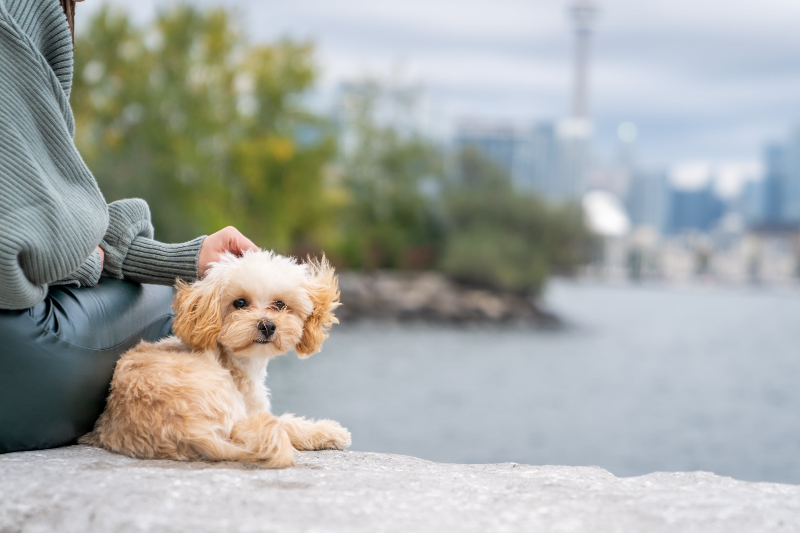What Should Be Important When Looking For a New Puppy?
Breeder Dr. Sheri Morris, ABVP, IVCA in her home in Logy Bay-Middle Cove-Outer Cove. PHOTO: CTV News.
How Do I Decide Where to Get a New Dog?
Whether you are looking for a puppy as a family pet, as a performance partner, or an all around
companion; whether you look for a mixed breed dog, an exotic cross breed or a registered CKC
breed and or show prospect, its hard to know where to start to try to make sense of what a
prospective pet owner should be looking for.
As I am a veterinarian for 34 years, a small animal practice owner, a dog breeder of CKC
registered dogs, I have a bunch of experience that might be helpful when you are looking to be
a dog buyer in Canada. This is certainly an opinion, and there are a lot of those out there, but
there are undoubtedly some things that could really help a person separate the wheat from the
chaff when looking for a dog.
Should I Get a Rescue Dog?
In the last few years, more and more dog rescue associations have encouraged, and may I
even say shamed the consumer into thinking the only option is rescuing a dog. Now I have
worked closely with nearly a 100 rescue organizations, and while many are good and well-
meaning animal lovers with good pets that just need a loving home, it is hard to tell what you
might get adopting a Rescue pet. With often an unknown or incomplete history, there could be
surprises! Some rescue groups import dogs from outside your geographical area, sometimes
from WAY out! This means that illnesses not present in your area can be imported along with
the pet! Diseases such as Rabies, distemper, and other exotic diseases have been known to be
imported from other parts of the world. Mixed breed dogs can also have just as many medical or
physical problems as any other individual dog, and recent research suggests the old thought
about “hybrid vigor” making mixed breed dogs more healthy does not necessarily hold true.
While the “rescue dog” might be available at slightly lower cost than a purebred, the vast
majority of the cost of dog ownership are the expenses over time. It is difficult to know what the
dog will look like, how big it will become when you adopt an unknown puppy. Behaviour traits in
purebred dogs are overall much more predictable to research before you buy and likely what
you would experience in a puppy of a particular breed when they come into your family.
What is a "Designer" Dog?
Few people acquainted with dogs would not have heard the term “Doodle”, a poodle crossed
with a “you name it” other breed. Humans have been selectively breeding dogs for particular
jobs for hundreds if not thousands of years. This is not inherently a bad thing. In recent times,
with the popularity of the “family dog”, sharp entrepreneurs have marketed designer dogs to fill
requests for non-shedding or dogs less likely to induce human allergies or that would be good in
the “family”. Thus the cross bred dog, with some characteristics of either or both the combined
breeds. The poodle, the base of many of these designer dogs is a gun dog waterfowl retriever at
its origin. It is a great swimming, long legged and athletic, and high energy and smart and
trainable. Bred to a Labrador, the most registered dog in North America for many years, is a
wonderful family dog. But size can be extremely variable, depending on the size of either of the
dogs.
The labradoodle is perhaps the oldest of the Designer dogs, and labradoodles do actually have
a parent breed club, the Australian Labradoodle Association, although without breed recognition by large associations such as AKC or CKC, these dogs are not eligible for showing.
This means that while conscientious breeders are ones that do genetic testing, hip radiographs
and eye certifications, without being part of North America’s Kennel Clubs, there is no place to
structurally compare an individual to each other to improve structure and function. While the
average pet owner doesn’t know about dog “structure” it is so important for dogs to be correct
and balanced to be healthy so they do not have orthopedic problems throughout their lives.
The World Australian Labradoodle Association (WALA)'s registry, all
other designer dogs that I have ever encountered as a veterinarian, are just one individual of
one breed crossed with another individual of a second breed. So those dogs may have all the
faults of the parents of either breed. In buying a dog like this, a good breeder should be testing
for the genetic problems of both breeds, and the resulting offspring are variable in the extreme. I
would be worried and ask a lot of questions about these crossbred dogs, and worry about why
they are selling for really exorbitant prices at times, really for no reason. There is no pedigree
analysis, no breeding to improve the next generation, just a profit motive. Having said that,
many Designer dogs are crosses of generally nice family dogs, so could be lovely family pets.
But buyer beware that profits might be the biggest motivation of the breeder, not improvement of
the dogs themselves.
Why Should I Consider a Purebred Dog?
As a Breeder myself and a veterinarian I absolutely am biased towards purebred Breeders, and
I will stipulate “good Breeders”. By that I mean that people who are committed to the Breed they
have chosen, are trying over time to make the next generation of dogs better than the ones
before them. They do that by showing their dogs to prove structural superiority against others in
the breed, supporting their Breed Clubs, keeping up to date with all the genetic tests important
in their breed, they test their breeding dogs’ hips, eyes, genetic makeup, and temperament and
they fail dogs who don’t measure up and remove them from breeding, because they won’t make
the breed better.
This doesn’t mean that every dog that has a genetic carrier state is not bred,
because it is important to maintain genetic diversity, but it is most important to KNOW what their
genetic status is, so we can make breeding decisions to avoid the avoidable and make more
genetically clear dogs. Understand, there are only some genetic traits that are even known in
dogs now. Some are multi-gene problems that we can’t yet know about, but our knowledge is
getting better due to research.
Breeders also balance all the testing they do with temperament, structure, coat type, working
ability and the like. They compare their dogs to written breed standards. This balancing act is
ultimately why Breeders who are committed to their breeds in this way are more likely to get you
a puppy that fits you and your family better than other sources of puppies out there and
available to you as a buyer. Even though individual dogs in a breed obviously can vary to a
degree in personality and looks, the purebred dog overall is pretty consistent in its looks and
behavior when you are looking for particular traits as a puppy buyer. This is much more difficult
to know when you are buying a rescue dog or a Designer dog.
Profit, for a good Breeder, may be, and I suggest likely IS less important than the commitment to
the dogs themselves as Breed Fanciers. In my experience as a practicing veterinarian over
many years (30+ years), most of the puppies that are sold this way are in many ways better,
and despite the testing and effort of their Breeders, no more expensive to obtain as a buyer if
you know where to look.
Most Breeders can only keep a few dogs for breeding: they pick who
they believe are the best of any litter to keep themselves or to put into Guardian Homes for
breeding screening, and sell the rest to loving pet homes which are wanted in our society. We try to fit puppy temperaments to what an owner wants in their family, their activity level, kids,
things that you do in your life. This ultimately makes a better pet ownership experience, which is
what everyone wants (including your dog!)
What Questions Should I ask A Breeder or Rescue?
1. For Rescue Organizations:
- Where do you get your dogs?
- Do they get examinations by a veterinarian, vaccinations and deworming?
- Do they have any testing before importation?
- Are they spayed or neutered before sale?
- If the dog is not working out in your family, can you return it to the rescue?
2. For Designer-type Dogs:
- What health/genetic testing is done for the parents AND the individual for sale
- What are the results of hip/elbow/eye/patella/dentition clearances for the dam and sire? Eye testing should be done annually or at least nearly annually during breeding life.
- Meet the Dam at very least, and maybe the Sire if available - what are they like?
- For labradoodles, are they part of the WALA registry?
- How many litters do your Dams generally have before retirement? This is not an absolute, but breeders trying to improve the breed, generally have better daughters to breed than their mothers by the time they have 3 or 4 litters.
- At what age are your females bred? Waiting until 24 months is ideal before breeding.
- These dogs should be sold on spay/neuter contracts if they are reputable Breeders.
3. For Purebred Dog Breeders:
- All of the questions above for Designer Dogs, AND
- Can the Breeder talk about common inherited conditions in their breed? Every breed has them, if they cannot talk AT LENGTH about these conditions, BEWARE!
- See the results of testing - reports or certificates.
- Do you show your dogs? To what level? Grand Champion? Champion? The levels are not so important to a pet buyer, but higher level certificates show you that their dogs have competed against more dogs of the same breed and won, they are structurally superior, so are less likely to have physical abnormalities, and superior structure generally means fewer conformation faults and leads to better function, less old age problems etc.
- How many dogs do you personally own? More is not necessarily bad, but having them living in the Breeder’s home, not in kennel housing all the time, is a better way to live for a breeding dog.
- Does the Breeder sell to Guardian Homes? For some pet owners it is both a fun thing to have your Breeder show your dog, generally the Breeder takes on the expense of any breeding costs and showing. You have to be willing to be available to have a few vet visits with the Breeder for testing purposes and breeding if the dog passes its testing. And the dog may have a few litters, so might be away from the family during whelping and puppy raising. But it may be a way to have a quality dog in your home, who would retire later with you in your loving home. And it normally comes with a reduced cost to buy the dog.
- Will the Breeder give you written information about what treatments have been given to the dog, and instructions for you after sale about what treatments and vaccinations are still needed for the puppy?
- And, in the end do you feel that this person is committed to the breed, are they reputable? If local, do they allow you to visit the puppies in your home? Can you have a video visit if not local?
Online sites such as Paction will, I hope, help Breeders connect with Buyers in a safer
situation for buyers, with reviews to help consumers navigate this question better over time.


